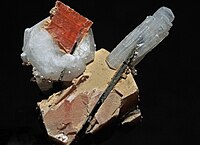
Photo from wikipedia
Abstract Heavy minerals are typically rare but important components of siliciclastic sediments and rocks. Their abundance, proportions, and variability carry valuable information on source rocks, climatic, environmental and transport conditions… Click to show full abstract
Abstract Heavy minerals are typically rare but important components of siliciclastic sediments and rocks. Their abundance, proportions, and variability carry valuable information on source rocks, climatic, environmental and transport conditions between source to sink, and diagenetic processes. They are important for practical purposes such as prospecting for mineral resources or the correlation and interpretation of geologic reservoirs. Despite the extensive use of heavy mineral analysis in sedimentary petrography and quite diverse methods for quantifying heavy mineral assemblages, there has never been a systematic comparison of results obtained by different methods and/or operators. This study provides the first interlaboratory test of heavy mineral analysis. Two synthetic heavy mineral samples were prepared with considerably contrasting compositions intended to resemble natural samples. The contributors were requested to provide (i) metadata describing methods, measurement conditions and experience of the operators and (ii) results tables with mineral species and grain counts. One hundred thirty analyses of the two samples were performed by 67 contributors, encompassing both classical microscopic analyses and data obtained by emerging automated techniques based on electron-beam chemical analysis or Raman spectroscopy. Because relatively low numbers of mineral counts (N) are typical for optical analyses while automated techniques allow for high N, the results vary considerably with respect to the Poisson uncertainty of the counting statistics. Therefore standard methods used in evaluation of round robin tests are not feasible. In our case the ‘true’ compositions of the test samples are not known. Three methods have been applied to determine possible reference values: (i) the initially measured weight percentages, (ii) calculation of grain percentages using estimates of grain volumes and densities, and (iii) the best-match average calculated from the most reliable analyses following multiple pragmatic and robust criteria. The range of these three values is taken as best approximation of the ‘true’ composition. The reported grain percentages were evaluated according to (i) their overall scatter relative to the most likely composition, (ii) the number of identified components that were part of the test samples, (iii) the total amount of mistakenly identified mineral grains that were actually not added to the samples, and (iv) the number of major components, which match the reference values with 95% confidence. Results indicate that the overall comparability of the analyses is reasonable. However, there are several issues with respect to methods and/or operators. Optical methods yield the poorest results with respect to the scatter of the data. This, however, is not considered inherent to the method as demonstrated by a significant number of optical analyses fulfilling the criteria for the best-match average. Training of the operators is thus considered paramount for optical analyses. Electron-beam methods yield satisfactory results, but problems in the identification of polymorphs and the discrimination of chain silicates are evident. Labs refining their electron-beam results by optical analysis practically tackle this issue. Raman methods yield the best results as indicated by the highest number of major components correctly quantified with 95% confidence and the fact that all laboratories and operators fulfil the criteria for the best-match average. However, a number of problems must be solved before the full potential of the automated high-throughput techniques in heavy mineral analysis can be achieved.
Journal Title: Earth-Science Reviews
Year Published: 2020
Link to full text (if available)
Share on Social Media: Sign Up to like & get
recommendations!